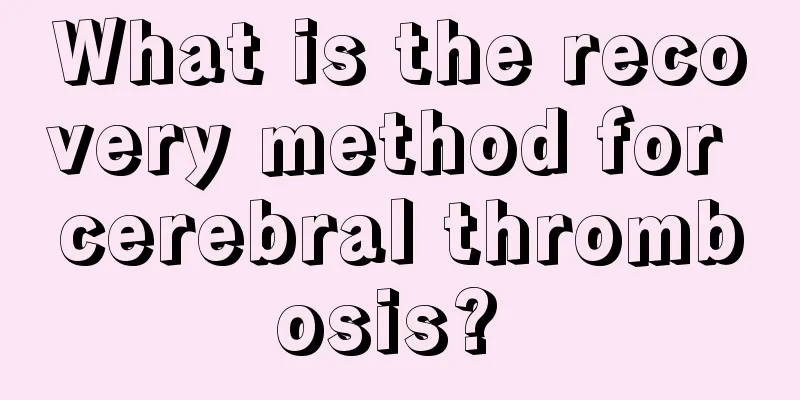What is the recovery method for cerebral thrombosis?

|
Cerebral thrombosis is a common cerebrovascular disease. This disease is more common in the elderly population. Cerebral thrombosis is potentially life-threatening, so treatment and recovery methods for cerebral thrombosis are very important. In order to recover from cerebral thrombosis, patients must pay attention to functional exercise. 1. Functional training should be gradual and persistent, and should not be rushed. The specific operation method is generally divided into three stages: The first stage: the patient is in the early stage of recovery and the hemiplegic limbs are completely unable to move. Exercise methods include massage, manipulation, and passive exercise, aiming to prevent muscle atrophy. These exercises can be completed with the assistance of family members. Generally, each local massage lasts 5-10 minutes, and full body massage does not exceed 30 minutes. Massage is to push forward along the paralyzed muscles with your fingers or palms. Passive exercise is when someone else moves the patient's paralyzed limbs, including every joint, large and small, and the range of motion is as close as possible to the range of motion of a normal joint. 2. The second stage: The paralyzed limbs begin to move but still have no strength to complete active movements. In addition to the methods of the first stage, limb exercises should also include turning over and sitting up, learning to stand with the help of others, holding the back of the chair or bed frame with both hands to move forward, and exercising the muscle strength and joint movement of the lower limbs on the paralyzed side. Usually the recovery of the paralyzed upper limb is slower and more difficult than that of the lower limb, which is related to the anatomical location of the brain nerve innervation. Initially, the shoulder joint is raised, abducted, and externally rotated with the help of others, and the elbow and finger joints are flexed and extended, gradually training to be able to move actively. In addition to early massage and passive exercise for the functional training of both hands, you should regularly do exercises such as flexion and extension, opening and closing of each finger, such as squeezing ping-pong balls, turning an abacus, unbuttoning buttons, holding keys, etc., to promote the recovery of finger function. 3. The third stage: The patient is in the late stage of recovery. This stage mainly focuses on practicing walking and fine finger movements. Practice walking independently, crossing thresholds, and going up and down stairs, but don’t get too tired at one time. It’s best to have someone to protect you. You can gradually increase the amount and distance of activity. Functional exercises for the upper limbs can further practice the flexibility and coordination of the hands, such as combing hair, hitting a ball, knitting, etc. |
<<: What causes frequent urination?
>>: What causes headaches, nausea, vomiting and sweating?
Recommend
What is the best way to treat oral herpes
If you get oral herpes, don't be too nervous....
How to make the most delicious black beans
How to cook black beans best? The nutritional val...
Massage method for lymphoma
Lymphocytes can resist the invasion of foreign ba...
Why are little girls' feet full of parasites
Parasites can grow in various parts of the human ...
How to check for anaplastic thyroid cancer
Undifferentiated thyroid cancer is a type of mali...
Is magnesium sulfate a precipitate?
Many people do not have a clear understanding of ...
Can I still have children after recovering from stage 3 prostate cancer
Prostate cancer is a major killer of men's he...
The difference between distilled water and purified water
Every day, we need to replenish 2500 ml of water ...
What are the bad habits that cause rectal cancer
In recent years, the incidence of rectal cancer i...
Will squats hurt your knees?
Many people will be deeply troubled by the proble...
What's wrong with the cramping pain in my left chest?
The symptoms of many diseases are similar, so doc...
What are the treatments for brain cancer
Brain cancer is a relatively serious brain diseas...
What can I apply to shrink pores
Every girl who loves beauty hopes that her skin w...
Causes of liver cancer in women
Liver cancer is a tumor disease of the liver. The...
Five ways to prevent stomach problems in autumn: strengthen exercise and prevent cold
During the cool autumn season, some people who su...









